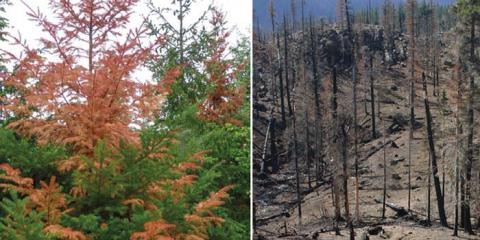Climate change and forestry
January 30, 2017
I was proud to represent Oregon forestry on a recent City Club of Portland panel discussing Oregon Agriculture in a Changing Climate. The impact of climate change on Oregon agriculture and forestry is an important topic. Here are some of the thoughts I shared in the discussion about how climate change is likely to affect Oregon forests.
There are several shifts that are happening to our climate in the Pacific Northwest. In general, the region is having warmer summer and winter temperatures, less precipitation in some areas and more in others, and more rain and less snow in the mountains.
So what does this mean for our forests? There are four main impacts a changing climate is likely to have on our forests.
Fire seasons will be longer. Historically, fire season started in Oregon around July 1 and ran until Oct. 1. In recent years, it has started two to three weeks earlier and lasted one to two weeks longer. Fires in June have been burning like it was July. This requires more resources to fight the fires. This also presents a need to increase the fire resiliency of our forests by thinning and reducing dry brush and other fuel that helps spread wildfires. Knowing that fire and drought will be more common, many foresters and landowners are thinning out the trees in their forests so there are fewer per acre. This allows the residual trees to be more fire- and drought-resistant than in denser stands of trees. Managing fire-prone forests is summarized in OFRI’s State of Fire special report.
Marginal forestland will be difficult to reforest if the trees are lost in a fire. The Barry Point fire on the Fremont-Winema National Forest near Lakeview burned thousands of acres and killed most of the trees. Because of the changing climate, it will be hard to restore these burned areas back to forestland. That’s because parts of the Fremont-Winema and surrounding areas are located in a part of Oregon where trees tend to grow more slowly and are less likely to survive. Climate change and fire have made it trickier to reforest these areas, because changing environmental conditions have made them better suited to grassland than forestland.
In drier forests with a mix of tree species, there will be a shift toward more drought-tolerant species. In southwestern Oregon, many of the forests are a mixture of Douglas-fir, ponderosa pine and hardwoods. Many private forest landowners in this region selectively harvest trees. Currently, landowners are harvesting more Douglas-fir and favoring leaving ponderosa pine and hardwoods standing because they can handle the drought better. In the mixed-conifer forests in central and eastern Oregon, foresters also manage primarily by harvesting selectively. In the face of a changing climate, foresters are preserving more ponderosa pine than Douglas-fir, grand fir or lodgepole pine, because ponderosa pine has better fire- and drought-resilience.
Douglas-fir will continue to be the species of choice in most northwest Oregon forests. Douglas-fir is a great tree. It has incredible properties that make it the species of choice for forest products. Doug-fir also has incredible genetic variation. It can survive and thrive in northwest Oregon even with a changing climate. The western hemlock, grand fir and western redcedar that grow in the same stands as Doug-fir are not as well equipped to thrive in a changing climate. It’s a blessing that our most valuable tree is also our best at adapting to a changing climate. However, foresters are continuing to plant a mix of species as extra insurance.
Oregon forests and forest landowners are a diverse and resilient lot. Recognizing that the climate is changing and how it is likely to affect our forests is allowing Oregon foresters and landowners to adapt our forest management accordingly.
For the forest,
Mike Cloughesy
Director of Forestry
